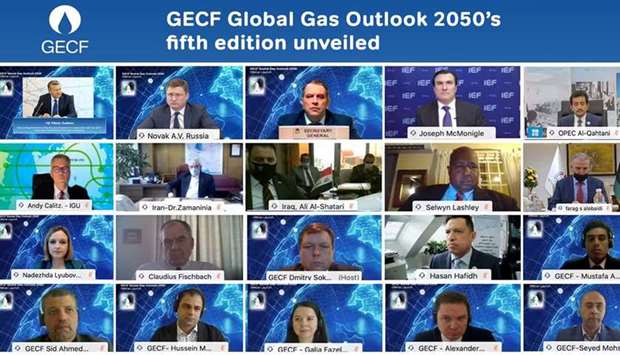Driven by Qatar and Iran, the Middle East gas production is expected to rise to 1,150bcm by 2050, Gas Exporting Countries Forum said Wednesday.
The two main contributors to natural gas production in the region are Iran and Qatar, with 50% and 30% respectively of total growth, GECF said while launching its Global Gas Outlook 2050’s fifth edition.
Europe, on the other hand, has been seeing declining gas production in the last ten years. This downward trend is expected to continue over the Outlook period with production falling from over 200bcm in 2019 to around 70bcm in 2050.
Cyprus is the only European country to see a growth in production by over 10 bcm over the forecast period, it said.
In Asia-Pacific, only China, Australia and India are expected to significantly expand production. China is expected to account for more than 85% of the growth of gas production in the region, particularly on account of its potential to produce gas from unconventional resources. Total Chinese gas production is expected to reach 370bcm by 2050, of which 72% will be unconventional gas.
Total Asia-Pacific production growth to 2050 is forecast to be 224bcm, of which only net growth of 20bcm is outside China. Australia is expected to grow production by 50bcm to reach almost 200bcm by 2050.
In North America, all three countries in the region (the US, Canada and Mexico) are expected to increase their production, with much of the growth being driven by new LNG export projects and new pipeline infrastructure.
Total production is expected to grow by 560bcm to reach 1,670bcm by 2050. Gas production in Eurasia is expected to increase by almost 40%, amounting to just under 1,300bcm by 2050.
Russia and Turkmenistan will source more than 78% and 17% of this expansion, respectively.
The impact of Covid-19 in 2020 is estimated to have led to around a 7% reduction in global energy-related CO2 emissions. This decline will be short-lived with a rebound in 2021 and 2022 as energy demand recovers.
In the reference case scenario (RCS), emissions grow moderately until 2030 before stabilising and plateauing at around 33.7GtCO2 over the 2030-2050 period.
Natural gas will contribute the least to emissions by 2050 (32%), despite its higher role in the hydrocarbons mix (39%), while coal will still account for a high share (33%) although its contribution to the hydrocarbons mix is much lower (23%). Further penetration of natural gas will lead to a greater potential for carbon mitigation.
The GECF has developed a Carbon Mitigation Scenario (CMS), assessing the future role of natural gas in reducing emissions. The CMS outlines the potential to mitigate emissions by 6.8GtCO2 in 2050 with an increasing penetration of gas and renewables.
These two fuels are set to increase their shares to 14% and 30%, respectively, by 2050, from 10% and 28% in the RCS. Although natural gas will play a role in reducing long-term emissions, with larger dissemination of proven and well-established technologies, there is a need to consider further decarbonization potential, including through blue hydrogen and CCUS options.
The two main contributors to natural gas production in the region are Iran and Qatar, with 50% and 30% respectively of total growth, GECF said while launching its Global Gas Outlook 2050’s fifth edition.
Europe, on the other hand, has been seeing declining gas production in the last ten years. This downward trend is expected to continue over the Outlook period with production falling from over 200bcm in 2019 to around 70bcm in 2050.
Cyprus is the only European country to see a growth in production by over 10 bcm over the forecast period, it said.
In Asia-Pacific, only China, Australia and India are expected to significantly expand production. China is expected to account for more than 85% of the growth of gas production in the region, particularly on account of its potential to produce gas from unconventional resources. Total Chinese gas production is expected to reach 370bcm by 2050, of which 72% will be unconventional gas.
Total Asia-Pacific production growth to 2050 is forecast to be 224bcm, of which only net growth of 20bcm is outside China. Australia is expected to grow production by 50bcm to reach almost 200bcm by 2050.
In North America, all three countries in the region (the US, Canada and Mexico) are expected to increase their production, with much of the growth being driven by new LNG export projects and new pipeline infrastructure.
Total production is expected to grow by 560bcm to reach 1,670bcm by 2050. Gas production in Eurasia is expected to increase by almost 40%, amounting to just under 1,300bcm by 2050.
Russia and Turkmenistan will source more than 78% and 17% of this expansion, respectively.
The impact of Covid-19 in 2020 is estimated to have led to around a 7% reduction in global energy-related CO2 emissions. This decline will be short-lived with a rebound in 2021 and 2022 as energy demand recovers.
In the reference case scenario (RCS), emissions grow moderately until 2030 before stabilising and plateauing at around 33.7GtCO2 over the 2030-2050 period.
Natural gas will contribute the least to emissions by 2050 (32%), despite its higher role in the hydrocarbons mix (39%), while coal will still account for a high share (33%) although its contribution to the hydrocarbons mix is much lower (23%). Further penetration of natural gas will lead to a greater potential for carbon mitigation.
The GECF has developed a Carbon Mitigation Scenario (CMS), assessing the future role of natural gas in reducing emissions. The CMS outlines the potential to mitigate emissions by 6.8GtCO2 in 2050 with an increasing penetration of gas and renewables.
These two fuels are set to increase their shares to 14% and 30%, respectively, by 2050, from 10% and 28% in the RCS. Although natural gas will play a role in reducing long-term emissions, with larger dissemination of proven and well-established technologies, there is a need to consider further decarbonization potential, including through blue hydrogen and CCUS options.



